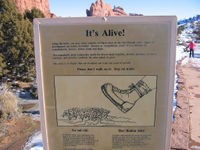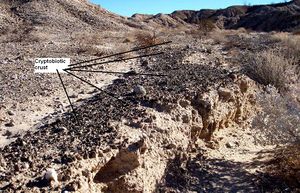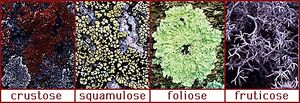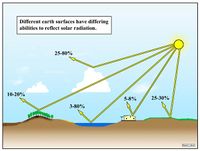Cryprogamic Soil Crust
Cryptogamic soil is a very thin layer of life consisting of a variety composition of living organisms including lichens, bryophytes, algae, fungi, cyanobacteria and mosses. These organism can play a huge part in stabilizing the top layer of soil (O Horizon ). This is beneficial in making sure that erosive forces like wind and water don't crumble away this important layer and leave the bedrock barren. Cryptogamic crust also can help maintain moisture levels and distribute it deeper into the soil layers along with other important processes such as nitrogen fixation. Depending on where the soil crust is located and which scholar you ask, soil crust can either help or not help vascular plants from establishing and flourishing. The fact that its only a thin layer on the surface, does mean its fragile and can easily be killed. This can be done by animals or humans walking over the crust. All it takes is one foot step to undo a hundred years of growth.

Habitat

These types of communities tend to inhabit areas that are arid and semi arid, such as the south western united states, Australia and Antarctica.Soil Crust communities are highly specialized community of cyanobacteria, mosses, and lichens that along with their biomass and waste products create the Solid crust that cover the surface of otherwise barren landscapes. A huge portion of landscapes Soil Structures begins with these communities.
Cyanobacteria
Cyanobacteria (a.k.a Cyanophyta) are photosynthetic bacteria, and are also the only photosynthetic prokaryotes who can produce oxygen by them selves. (Fun fact, which means they are being studied to try and help the renewable energy goals set by the Paris accord)
They can be found in almost all terrestrial and aquatic ecosystem, the most common of which to be found in Soil Crusts are those in the Micorcoleus genus and Nostoc genus. Which are large filamentous species that from filaments that are covered in Polysaccharides (Polysaccharides are a polymeric carbohydraye molecules). These Polysaccharides are sheaths that stabilize the small layer of soil that the Soil Crust is forming on, thus helping it to accumulate and grow. Eventually becoming thick enough for the next stage of restoration to occur. Unless its at a high elevation (i.e a windy mountain top), where it will not be replaced by the next stage of restoration.
Lichens
Lichens are a composite organism, the consist of many different types on individuals working together for a common goal, survival. Lichen arise from cyanobacteria and/or algae which are already living among a fungus in a symbiotic lifestyle. Thus creating a new organism that looks and behaves very different then its "parent" organisms. They are distinguished by their growth patterns and because of this they can be used to age past events. This is done by measuring their radial size and then based on this it can the age can be inferred.
Lichens are one of the first living things to start colonizing on barren rock after an event that stripped it of its soil. It starts the process of forming new soil. It does this by releasing acids that break down the rock as it grows over time. This releases rock material and when the lichen dies it is turned into a small layer of soil for the next stage of restoration to occur in. Lichens can also do Nitrogen and carbon fixation, as well as producing a array of different colors due to different pigments they release.
Type of Lichens

Crustose:Are crustlike growing tight against the substrate [8].
Foliose: These lichen have the unique ability to change their reproductive habits based purely on environmental stresses. The more disturbances their are, the more they use sexual reproduction. They have a leaflike shape with flat sheets of tissue not tightly bound [8].
Squamulose: These lichen are often small overlapping segments called squamules. They are tightly clustered and slightly flattened pebble-like units [8]
Fruticose: Look like free standing branching tubes [8].
Despite the wide diversity of the basic growth forms of lichens, they all have a similar morphology. The bulk of there body is formed from filaments of the fungal partnern, and the relative destiny of these filaments defines the layers within the lichen [8]. At the outer layers the filaments are tightly packed and form the cortex, the dense cortex keeps out other organisms and helps to reduce the intensity of light which can damage alga cells [8]. Below the algal layer is the medulla, which is a loosely woven layer of fungal filaments, in foliose lichens there is a second cortex below the medulla, but in crustose and squamulose the medulla is in direct contact with the underlying substate [8].

Impact

Albedo : Depending on which crust community you look at, they have a range of different colors, which differ from the surface they are growing on. Thus they are changing the albedo of that local area, this can either increase or decrease the local temperature, in most cases it is increased. They also perform ecological functions that benefit the surrounding environment.
Soil Stability : The habitats where Soil Crust form are areas where other plant growth is slow and in most places non-existent. Therefore soil growth is slow will be slow and soil erosion can be high. Where cryptogrammic crust forms it binds, and strengthens the soil which will help counteract erosion.
Water Infiltration: Cryptogramic Soil Crust communities can have an effect on a regions hydrologic cycle. Things that can be affected including absorbance and retention abilities of the soil, along with soil porosity of the soil. These changes can effect how the rain and runoff water interacts at the surface.
References
1) Anderson, David C., et al. “Factors Influencing Development of Cryptogamic Soil Crusts in Utah Deserts.” Journal of Range Management, vol. 35, no. 2, 1982, p. 180., doi:10.2307/3898386.
2)Lesica, et al. “The Effects of Cryptogamic Soil Crust on the Population Dynamics of Arabis Fecunda (Brassicaceae) /.” Details - The Effects of Cryptogamic Soil Crust on the Population Dynamics of Arabis Fecunda (Brassicaceae) /, Helena, Mt. :Montana Natural Heritage Program,[1991], 1 Jan. 1991, www.biodiversitylibrary.org/bibliography/35812.
3)Ahmadjian, V. The nature of lichens:31-36.
4)Gallery - Utah Lichens, www.tanelorn.us/data/utah_08/gal_utah_bio1.htm.
5)Belnap, Jayne (August 5, 2013). "Cryptobiotic Soils: Holding the Place in Place". U.S. Geological Survey. Archived from the original on May 10, 2016. Retrieved May 10, 2016.
6) Dobson, F.S. (2011). Lichens, an illustrated guide to the British and Irish species. Slough, England: Richmond Publishing Co. Ltd. ISBN 9780855463151.
7)Rambling, Clark. “Valley Of Fire State Park.” Road Runner, 1 Jan. 1970, clarkrambling.blogspot.com/2015/04/valley-of-fire-state-park.html.
8) Berkeley, U. 1997. Lichens: More on Morphology. UC Berkeley. https://ucmp.berkeley.edu/fungi/lichens/lichenmm.html